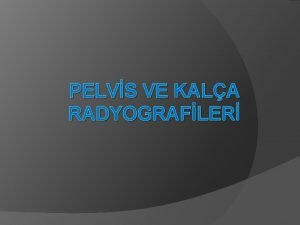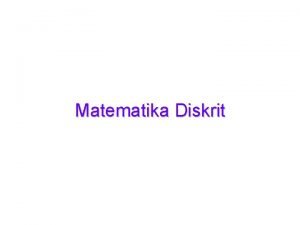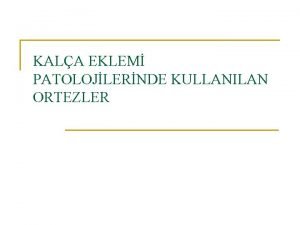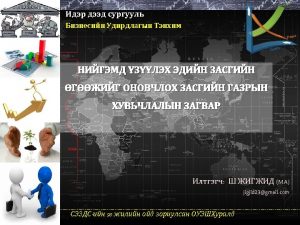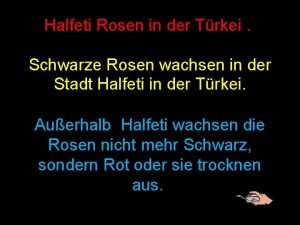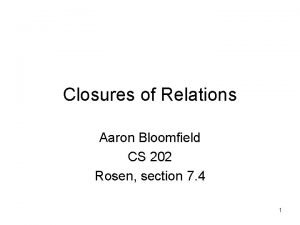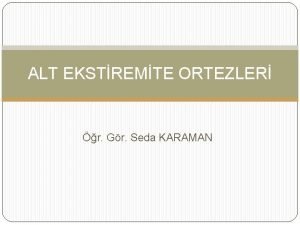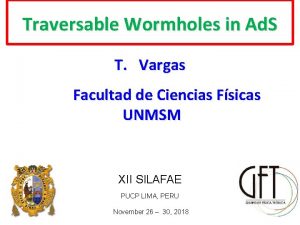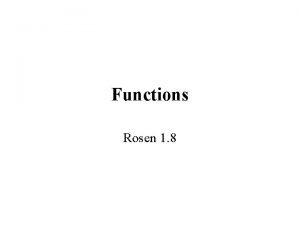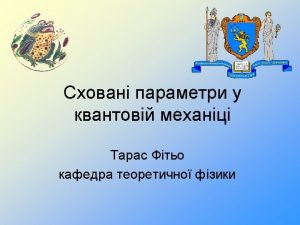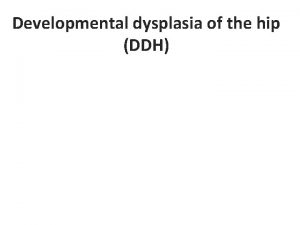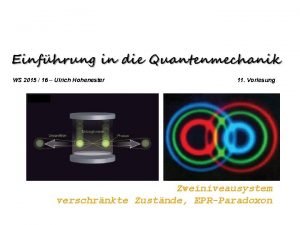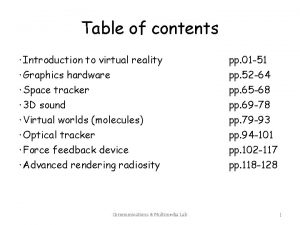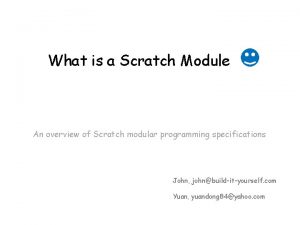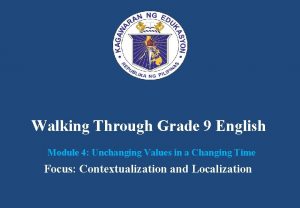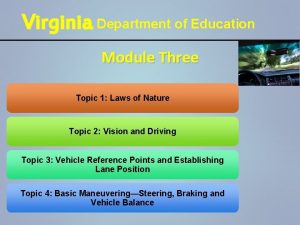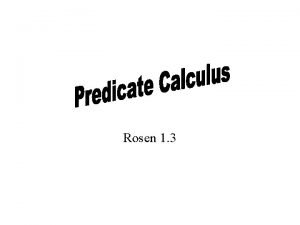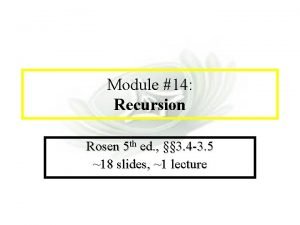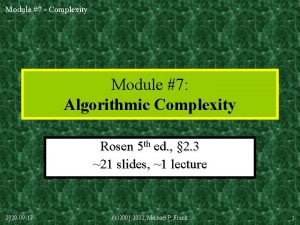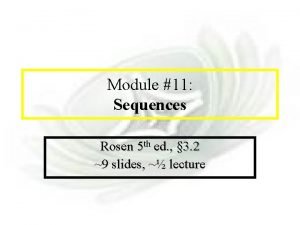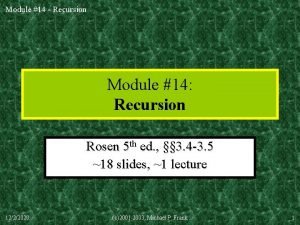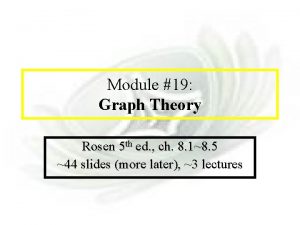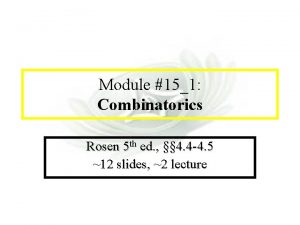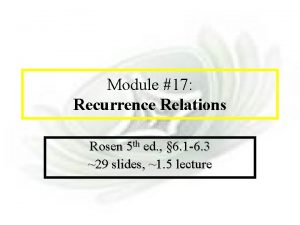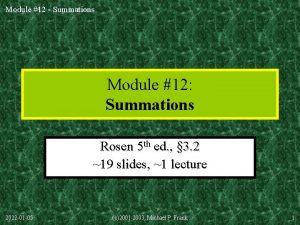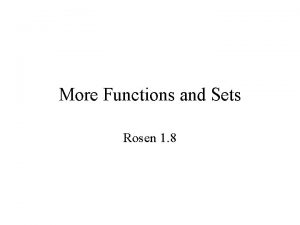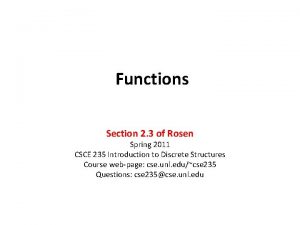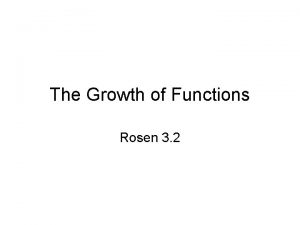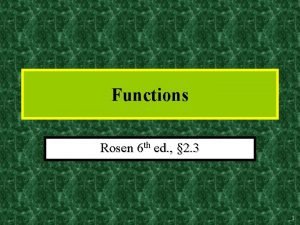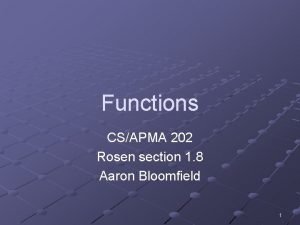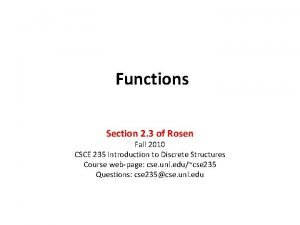Module 4 Functions Module 4 Functions Rosen 5











































- Slides: 43

Module #4 - Functions Module #4: Functions Rosen 5 th ed. , § 1. 8 ~44 slides, ~2 lectures 11/27/2020 (c)2001 -2003, Michael P. Frank 1

Module #4 - Functions On to section 1. 8… Functions • From calculus, you are familiar with the concept of a real-valued function f, which assigns to each number x R a particular value y=f(x), where y R. • But, the notion of a function can also be naturally generalized to the concept of assigning elements of any set to elements of any set. 11/27/2020 (c)2001 -2003, Michael P. Frank 2

Module #4 - Functions Function: Formal Definition • For any sets A, B, we say that a function f from (or “mapping”) A to B (f: A B) is a particular assignment of exactly one element f(x) B to each element x A. • Some further generalizations of this idea: – A partial (non-total) function f assigns zero or one elements of B to each element x A. – Functions of n arguments; relations (ch. 6). 11/27/2020 (c)2001 -2003, Michael P. Frank 3

Module #4 - Functions Graphical Representations • Functions can be represented graphically in several ways: f a • A f • b B Like Venn diagrams 11/27/2020 A B • • y • • • Bipartite Graph (c)2001 -2003, Michael P. Frank x Plot 4

Module #4 - Functions We’ve Seen So Far • A proposition can be viewed as a function from “situations” to truth values {T, F} – A logic system called situation theory. – p=“It is raining. ”; s=our situation here, now – p(s) {T, F}. • A propositional operator can be viewed as a function from ordered pairs of truth values to truth values: ((F, T)) = T. 11/27/2020 Another example: →((T, F)) = F. (c)2001 -2003, Michael P. Frank 5

Module #4 - Functions More functions so far… • A predicate can be viewed as a function from objects to propositions (or truth values): P : ≡ “is 7 feet tall”; P(Mike) = “Mike is 7 feet tall. ” = False. • A bit string B of length n can be viewed as a function from the numbers {1, …, n} (bit positions) to the bits {0, 1}. E. g. , B=101 B(3)=1. 11/27/2020 (c)2001 -2003, Michael P. Frank 6

Module #4 - Functions Still More Functions • A set S over universe U can be viewed as a function from the elements of U to {T, F}, saying for each element of U whether it is in S. S={3}; S(0)=F, S(3)=T. • A set operator such as , , can be viewed as a function from pairs of sets to sets. – Example: (({1, 3}, {3, 4})) = {3} 11/27/2020 (c)2001 -2003, Michael P. Frank 7

Module #4 - Functions A Neat Trick • Sometimes we write YX to denote the set F of all possible functions f: X Y. • This notation is especially appropriate, because for finite X, Y, |F| = |Y||X|. • If we use representations F 0, T 1, 2: {0, 1}={F, T}, then a subset T S is just a function from S to 2, so the power set of S (set of all such fns. ) is 2 S in this notation. 11/27/2020 (c)2001 -2003, Michael P. Frank 8

Module #4 - Functions Some Function Terminology • If f: A B, and f(a)=b (where a A & b B), then: – A is the domain of f. – B is the codomain of f. – b is the image of a under f. – a is a pre-image of b under f. • In general, b may have more than 1 pre-image. – The range R B of f is {b | a f(a)=b }. 11/27/2020 (c)2001 -2003, Michael P. Frank 9

Module #4 - Functions Range versus Codomain • The range of a function might not be its whole codomain. • The codomain is the set that the function is declared to map all domain values into. • The range is the particular set of values in the codomain that the function actually maps elements of the domain to. 11/27/2020 (c)2001 -2003, Michael P. Frank 10

Module #4 - Functions Range vs. Codomain - Example • Suppose I declare to you that: “f is a function mapping students in this class to the set of grades {A, B, C, D, E}. ” • At this point, you know f’s codomain is: _____, and its range is ____. {A, B, C, D, E} unknown! • Suppose the grades turn out all As and Bs. {A, B} but its • Then the range of f is _____, codomain is _________. still {A, B, C, D, E}! 11/27/2020 (c)2001 -2003, Michael P. Frank 11

Module #4 - Functions Operators (general definition) • An n-ary operator over the set S is any function from the set of ordered n-tuples of elements of S, to S itself. • E. g. , if S={T, F}, can be seen as a unary operator, and , are binary operators on S. • Another example: and are binary operators on the set of all sets. 11/27/2020 (c)2001 -2003, Michael P. Frank 12

Module #4 - Functions Constructing Function Operators • If (“dot”) is any operator over B, then we can extend to also denote an operator over functions f: A B. • E. g. : Given any binary operator : B B B, and functions f, g: A B, we define (f g): A B to be the function defined by: a A, (f g)(a) = f(a) g(a). 11/27/2020 (c)2001 -2003, Michael P. Frank 13

Module #4 - Functions Function Operator Example • , × (“plus”, “times”) are binary operators over R. (Normal addition & multiplication. ) • Therefore, we can also add and multiply functions f, g: R R: – (f g): R R, where (f g)(x) = f(x) g(x) – (f × g): R R, where (f × g)(x) = f(x) × g(x) 11/27/2020 (c)2001 -2003, Michael P. Frank 14

Module #4 - Functions Function Composition Operator • For functions g: A B and f: B C, there is a special operator called compose (“○”). – It composes (creates) a new function out of f, g by applying f to the result of g. – (f○g): A C, where (f○g)(a) = f(g(a)). – Note g(a) B, so f(g(a)) is defined and C. – Note that ○ (like Cartesian , but unlike +, , ) is non-commuting. (Generally, f○g g○f. ) 11/27/2020 (c)2001 -2003, Michael P. Frank 15

Module #4 - Functions Images of Sets under Functions • Given f: A B, and S A, • The image of S under f is simply the set of all images (under f) of the elements of S. f(S) : {f(s) | s S} : {b | s S: f(s)=b}. • Note the range of f can be defined as simply the image (under f) of f’s domain! 11/27/2020 (c)2001 -2003, Michael P. Frank 16

Module #4 - Functions One-to-One Functions • A function is one-to-one (1 -1), or injective, or an injection, iff every element of its range has only 1 pre-image. – Formally: given f: A B, “x is injective” : ( x, y: x y f(x) f(y)). • Only one element of the domain is mapped to any given one element of the range. – Domain & range have same cardinality. What about codomain? • Each element of the domain is injected into a different element of the range. – Compare “each dose of vaccine is injected into a different patient. ” 11/27/2020 (c)2001 -2003, Michael P. Frank 17

Module #4 - Functions One-to-One Illustration • Bipartite (2 -part) graph representations of functions that are (or not) one-to-one: • • • One-to-one 11/27/2020 • • • Not one-to-one (c)2001 -2003, Michael P. Frank • • • Not even a function! 18

Module #4 - Functions Sufficient Conditions for 1 -1 ness • For functions f over numbers, – f is strictly (or monotonically) increasing iff x>y f(x)>f(y) for all x, y in domain; – f is strictly (or monotonically) decreasing iff x>y f(x)<f(y) for all x, y in domain; • If f is either strictly increasing or strictly decreasing, then f is one-to-one. E. g. x 3 – Converse is not necessarily true. E. g. 1/x 11/27/2020 (c)2001 -2003, Michael P. Frank 19

Module #4 - Functions Onto (Surjective) Functions • A function f: A B is onto or surjective or a surjection iff its range is equal to its codomain ( b B, a A: f(a)=b). • An onto function maps the set A onto (over, covering) the entirety of the set B, not just over a piece of it. • E. g. , for domain & codomain R, x 3 is onto, whereas x 2 isn’t. (Why not? ) 11/27/2020 (c)2001 -2003, Michael P. Frank 20

Module #4 - Functions Illustration of Onto • Some functions that are or are not onto their codomains: • • • Onto (but not 1 -1) 11/27/2020 • • • Not Onto (or 1 -1) • • Both 1 -1 and onto (c)2001 -2003, Michael P. Frank • • • 1 -1 but not onto 21

Module #4 - Functions Bijections • A function f is a one-to-one correspondence, or a bijection, or reversible, or invertible, iff it is both one-toone and onto. • For bijections f: A B, there exists an inverse of f, written f 1: B A, which is the unique function such that (the identity function) 11/27/2020 (c)2001 -2003, Michael P. Frank 22

Module #4 - Functions The Identity Function • For any domain A, the identity function I: A A (variously written, IA, 1, 1 A) is the unique function such that a A: I(a)=a. • Some identity functions you’ve seen: – ing 0, ·ing by 1, ing with T, ing with F, ing with U. • Note that the identity function is both one-to -one and onto (bijective). 11/27/2020 (c)2001 -2003, Michael P. Frank 23

Module #4 - Functions Identity Function Illustrations • The identity function: • • y • • x Domain and range 11/27/2020 (c)2001 -2003, Michael P. Frank 24

Module #4 - Functions A Fun Application • In a computer, the function mapping state at clock cycle #t to state at clock cycle #t+1 is called the computer’s transition function. • If the transition function is reversible (a bijection), then the computer’s operation in theory requires no energy expenditure. • The study of low-power reversible computing techniques based on this idea is my primary research area. 11/27/2020 (c)2001 -2003, Michael P. Frank 25

Module #4 - Functions Graphs of Functions • We can represent a function f: A B as a set of ordered pairs {(a, f(a)) | a A}. • Note that a, there is only 1 pair (a, f(a)). – Later (ch. 6): relations loosen this restriction. • For functions over numbers, we can represent an ordered pair (x, y) as a point on a plane. A function is then drawn as a curve (set of points) with only one y for each x. 11/27/2020 (c)2001 -2003, Michael P. Frank 26

Module #4 - Functions Comment About Representations • You can represent any type of discrete structure (propositions, bit-strings, numbers, sets, ordered pairs, functions) in terms of virtually any of the other structures (or some combination thereof). • Probably none of these structures is truly more fundamental than the others (whatever that would mean). However, strings, logic, and sets are often used as the foundation for all else. E. g. in 11/27/2020 (c)2001 -2003, Michael P. Frank 27

Module #4 - Functions A Couple of Key Functions • In discrete math, we will frequently use the following functions over real numbers: – x (“floor of x”) is the largest (most positive) integer x. – x (“ceiling of x”) is the smallest (most negative) integer x. 11/27/2020 (c)2001 -2003, Michael P. Frank 28

Module #4 - Functions Visualizing Floor & Ceiling • Real numbers “fall to their floor” or “rise to their ceiling. ” 3. 2. • Note that if x Z, . 1 x x & 0 x x . 1. • Note that if x Z, . 2 x = x. . 3 1. 6 =2 1. 6 =1 1. 4 = 2 3 3 = 3 11/27/2020 (c)2001 -2003, Michael P. Frank 29

Module #4 - Functions Plots with floor/ceiling Note that for f(x)= x , the graph of f includes the point (a, 0) for all values of a such that a 0 and a<1, but not for a=1. We say that the set of points (a, 0) that is in f does not include its limit or boundary point (a, 1). Sets that do not include all of their limit points are called open sets. In a plot, we draw a limit point of a curve using an open dot (circle) if the limit point is not on the curve, and with a closed (solid) dot if it is on the curve. 11/27/2020 (c)2001 -2003, Michael P. Frank 30

Module #4 - Functions Plots with floor/ceiling: Example • Plot of graph of function f(x) = x/3 : f(x) Set of points (x, f(x)) +2 3 +3 x 2 11/27/2020 (c)2001 -2003, Michael P. Frank 31

Module #4 - Functions Review of § 1. 8 (Functions) • • • Function variables f, g, h, … Notations: f: A B, f(a), f(A). Terms: image, preimage, domain, codomain, range, one-to-one, onto, strictly (in/de)creasing, bijective, inverse, composition. • Function unary operator f 1, binary operators , , etc. , and ○. • The R Z functions x and x. 11/27/2020 (c)2001 -2003, Michael P. Frank 32

Module #4 - Functions Topic #∞ Module #4, Topic #∞: Cardinality & Infinite Sets Rosen 5 th ed. , § 3. 2 ~1 lecture 11/27/2020 (c)2001 -2003, Michael P. Frank 33

Module #4 - Functions Infinite Cardinalities (from § 3. 2) • Using what we learned about functions in § 1. 8, it’s possible to formally define cardinality for infinite sets. • We show that infinite sets come in different sizes of infinite! • This gives us some interesting proof examples, in anticipation of chapter 3. 11/27/2020 (c)2001 -2003, Michael P. Frank 34

Module #4 - Functions Cardinality: Formal Definition • For any two (possibly infinite) sets A and B, we say that A and B have the same cardinality (written |A|=|B|) iff there exists a bijection (bijective function) from A to B. • When A and B are finite, it is easy to see that such a function exists iff A and B have the same number of elements n N. 11/27/2020 (c)2001 -2003, Michael P. Frank 35

Module #4 - Functions Countable versus Uncountable • For any set S, if S is finite or |S|=|N|, we say S is countable. Else, S is uncountable. • Intuition behind “countable: ” we can enumerate (generate in series) elements of S in such a way that any individual element of S will eventually be counted in the enumeration. Examples: N, Z. • Uncountable: No series of elements of S (even an infinite series) can include all of S’s elements. Examples: R, R 2, P(N) 11/27/2020 (c)2001 -2003, Michael P. Frank 36

Module #4 - Functions Countable Sets: Examples • Theorem: The set Z is countable. – Proof: Consider f: Z N where f(i)=2 i for i 0 and f(i) = 2 i 1 for i<0. Note f is bijective. • Theorem: The set of all ordered pairs of natural numbers (n, m) is countable. – Consider listing the pairs in order by their sum s=n+m, then by n. Every pair appears once in this series; the generating function is bijective. 11/27/2020 (c)2001 -2003, Michael P. Frank 37

Module #4 - Functions Uncountable Sets: Example • Theorem: The open interval [0, 1) : {r R| 0 r < 1} is uncountable. • Proof by diagonalization: (Cantor, 1891) Georg Cantor 1845 -1918 – Assume there is a series {ri} = r 1, r 2, . . . containing all elements r [0, 1). – Consider listing the elements of {ri} in decimal notation (although any base will do) in order of increasing index: . . . (continued on next slide) 11/27/2020 (c)2001 -2003, Michael P. Frank 38

Module #4 - Functions Uncountability of Reals, cont’d A postulated enumeration of the reals: r 1 = 0. d 1, 1 d 1, 2 d 1, 3 d 1, 4 d 1, 5 d 1, 6 d 1, 7 d 1, 8… r 2 = 0. d 2, 1 d 2, 2 d 2, 3 d 2, 4 d 2, 5 d 2, 6 d 2, 7 d 2, 8… r 3 = 0. d 3, 1 d 3, 2 d 3, 3 d 3, 4 d 3, 5 d 3, 6 d 3, 7 d 3, 8… r 4 = 0. d 4, 1 d 4, 2 d 4, 3 d 4, 4 d 4, 5 d 4, 6 d 4, 7 d 4, 8…. Now, consider a real number generated by taking. all digits di, i that lie along the diagonal in this figure. and replacing them with different digits. 11/27/2020 (c)2001 -2003, Michael P. Frank 39

Module #4 - Functions Uncountability of Reals, fin. • E. g. , a postulated enumeration of the reals: r 1 = 0. 301948571… r 2 = 0. 103918481… r 3 = 0. 039194193… r 4 = 0. 918237461… • OK, now let’s add 1 to each of the diagonal digits (mod 10), that is changing 9’s to 0. • 0. 4103… can’t be on the list anywhere! 11/27/2020 (c)2001 -2003, Michael P. Frank 40

Module #4 - Functions Transfinite Numbers • The cardinalities of infinite sets are not natural numbers, but are special objects called transfinite cardinal numbers. • The cardinality of the natural numbers, 0: |N|, is the first transfinite cardinal number. (There are none smaller. ) • The continuum hypothesis claims that |R|= 1, the second transfinite cardinal. 11/27/2020 (c)2001 -2003, Michael P. Frank 41

Module #4 - Functions Do Uncountable Sets Really Exist? • The set of objects that can be defined using finite-length strings of symbols (“descriptions”) is only countable. • Therefore, any uncountable set must consist primarily of elements which individually have no finite description. • Löwenheim-Skolem theorem: No consistent theory can ever force an interpretation involving uncountables. • The “constructivist school” asserts that only objects constructible from finite descriptions exist. (e. g. R) • Most mathematicians are happy to use uncountable sets anyway, because postulating their existence has not led to any demonstrated(c)2001 -2003, contradictions (so far). 11/27/2020 Michael P. Frank 42

Module #4 - Functions Countable vs. Uncountable • You should: – Know how to define “same cardinality” in the case of infinite sets. – Know the definitions of countable and uncountable. – Know how to prove (at least in easy cases) that sets are either countable or uncountable. 11/27/2020 (c)2001 -2003, Michael P. Frank 43
 Du machst mich immer noch verrückt nach all jahren
Du machst mich immer noch verrückt nach all jahren Eddie rosen brian rosen
Eddie rosen brian rosen C device module module 1
C device module module 1 Sophie rosen
Sophie rosen Quadruple constraint
Quadruple constraint Iliak oblik grafi
Iliak oblik grafi Lateral pillar classification
Lateral pillar classification Kenneth rosen discrete mathematics pdf
Kenneth rosen discrete mathematics pdf Scottish rite ortezi
Scottish rite ortezi Mussa rosen
Mussa rosen Rosa halfeti
Rosa halfeti The car trip michael rosen
The car trip michael rosen Rosen
Rosen Scienza delle finanze rosen
Scienza delle finanze rosen Walter g. rosen
Walter g. rosen Yrye
Yrye Writing a recount of a school trip
Writing a recount of a school trip 10 rosen für dich
10 rosen für dich Gao jafferis wall
Gao jafferis wall Ncblpc
Ncblpc Birgitta rosen logoped
Birgitta rosen logoped Function or not a function
Function or not a function Epr einstein podolsky rosen
Epr einstein podolsky rosen Von rosen sign
Von rosen sign Dr carol rosen
Dr carol rosen Eaton-rosen phenomenon
Eaton-rosen phenomenon John rosen
John rosen Antikorreliert
Antikorreliert Alpha and beta angle in ddh
Alpha and beta angle in ddh Jacob rosen ucla
Jacob rosen ucla Von rosen splint
Von rosen splint Handshaking lemma
Handshaking lemma Kajiya rendering equation
Kajiya rendering equation Calculus
Calculus Jacob rosen ucla
Jacob rosen ucla Burnham rosen group
Burnham rosen group Absolute value functions as piecewise functions
Absolute value functions as piecewise functions Evaluating functions
Evaluating functions Evaluating functions and operations on functions
Evaluating functions and operations on functions Scratch module
Scratch module Grade 9 english module
Grade 9 english module Gestalt psychology illusions
Gestalt psychology illusions Drivers ed module 3 topic 1
Drivers ed module 3 topic 1 Curriculum guide for driver education in virginia module 10
Curriculum guide for driver education in virginia module 10





